- The Best Shade Tolerant Grass Varieties You Need to Know - September 8, 2021
But how vital is sunlight for grass? Light shade conditions affect the vigor of grass and its parts – roots, rhizomes, stolon, and shoots.
But if you insist on having a lovely mat of grass in your shaded yard, all is not lost. Some grass varieties do tolerate shade – St. Augustine, Zoysia, and Tall Fescue. But keep in mind, all grasses need some amount of light; even indirectly, there is no such thing as a completely shade tolerant grass variety.
Shade Tolerant Grass Varieties
In general, some warm-season grasses will do well in the shady yards of warm climates. These include St. Augustine and Zoysia.
However, the colder the climate, it is better to plant cool-season grasses such as Tall Fescue in shady spots.
Below are some shade-tolerant grass varieties that you should consider growing. However, it depends mainly on the amount of shade and the climate in your area. Each type has its preference in terms of growing conditions, so read carefully.
St. Augustine Grass
You can plant St. Augustine grass on a shady lawn. But, ensure that your climate is sufficiently warm. This grass will only strive in warm and humid subtropical to tropical climates.
How to Identify
St. Augustine grass has a blue-green color and a compact growing habit. It is a relatively thick and tough grass.
Where does St. Augustine Grass Grow?
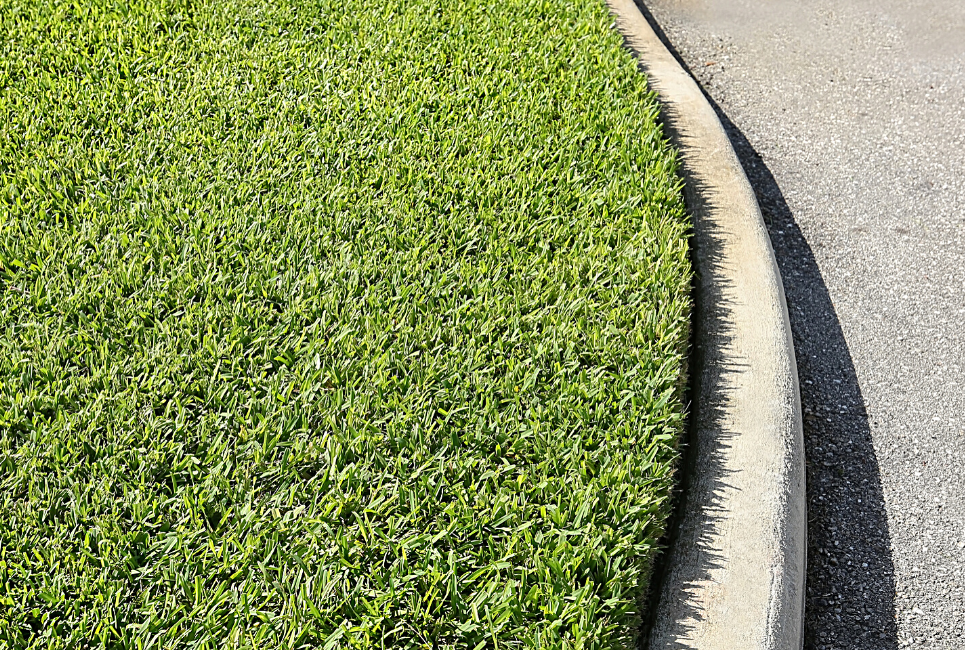
Being a warm-season grass variety, St. Augustine grass strives in temperatures between 75 to 90 degrees Fahrenheit (23.9 to 32 Celsius) . This variety will tolerate extremely high temperatures and even during periods of low rainfall.
St. Augustine grass tolerates heat and salt, contributing to its popularity across warmer and humid states like Florida and the Gulf Coast States.
St. Augustine grows in USDA zones 8 to 10 but will strive far better in zone 10 than 8. Unless your climate is tropical, the grass will turn brown and go dormant during the colder months.
How to Plant St. Augustine Grass
You can start growing St. Augustine grass with seeds, plugs, or grass sod. Regardless of the planting method, During the first week or two after planting, St. Augustine grass requires frequent watering several times during the day. Once roots are formed, irrigate once per day at a rate of ¼ to ½ inch (6 mm to 1 cm). Water your grass less frequently once the grasses are fully established.
Seeds
Traditionally St. Augustine grass seed has not been used to establish lawns but new methods make this a viable approach.
After preparing the law, plant seeds at a rate of 1/3 to ½ pound (0.15 to 0.23 kg) per 1,000 square feet (93 sq. m.).
Do this before or after the hottest portions of the year – in early spring or late summer. Be sure to keep your grass seeds moist until they are established. Without frequent rainfall, water regularly ensures that the soil does not dry out.
Plugs
Plugs are usually the way to go – most gardeners prefer planting St. Augustine grass this way. Place plugs about 6 to 12 inches (15-31 cm) apart on your prepared lawn.
How to Care for St. Augustine Grass
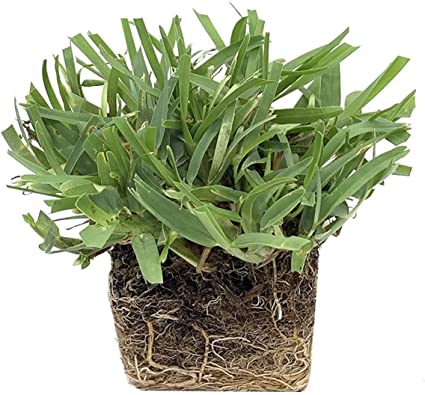
St. Augustine grass is a low-maintenance variety and will perform well even with little care.
Soil
St. Augustine strives in well-drained, sandy soils. It does not do well in waterlogged or compacted clay soils. A soil pH of 5-8.5 is fine, but more on the acidic side is better.
Light
St. Augustine grass needs plenty of sunlight. However, it may do fine in partial shade.
Mowing
Mow your St. Augustine grass two weeks after planting – to about 1 to 3 inches (2.5 – 8 cm) in height. Mow every week or two, depending on your preferred height and how fast the grass grows. In warm and humid conditions, growth tends to be more than in drier and cooler periods.
Fertilizing
St. Augustine grass benefits from about a pound of nitrogen-rich fertilizer every 30 to 60 days. Apply fertilizer from spring through fall. Nitrogen is essential for vegetative growth, so when choosing a fertilizer, go with a pure nitrogen variety or a product designed exclusively for grasses.
Watering
Give your St. Augustine grass about 1 inch (2.54 cm) of water a week to keep it green. If you overwater, it may develop a fungal infection and turn brown.
Fertilizing
St. Augustine grass benefits from about a pound of nitrogen-rich fertilizer every 30 to 60 days. Apply fertilizer from spring through fall. Nitrogen is essential for vegetative growth, so when choosing a fertilizer, go with a pure nitrogen variety or a product designed exclusively for grasses.
Common St. Augustine Grass Problems
Grubs and sod worms are the pests that most gardeners report. Thankfully, you can control them with insecticide applications in spring and mid-season. Typical applications are about twice yearly but check with the manufacturer for exact instructions and timing.
Lots of moisture retention in the yard may cause fungi to appear. This event usually happens because of heavy and frequent rain or overwatering. Moisture retention is possible if your lawn does not get much sunlight which is helpful for moisture evaporation. Fungal turf diseases such as brown patches and gray leaf spots may affect your St. Augustine lawn. Applying fungicides early in the summer may help to prevent these diseases before they become an issue. If you are too late, grab a good-quality fungicide product and apply it according to the manufacturer’s instructions.
Weeds tend not to be a problem for the densely growing St. Augustine variety. Healthy turf will choke out weeds. But also, the application of pre-emergency herbicides can be used if broadleaf weeds are a consistent threat where you live.
Zoysia Grass
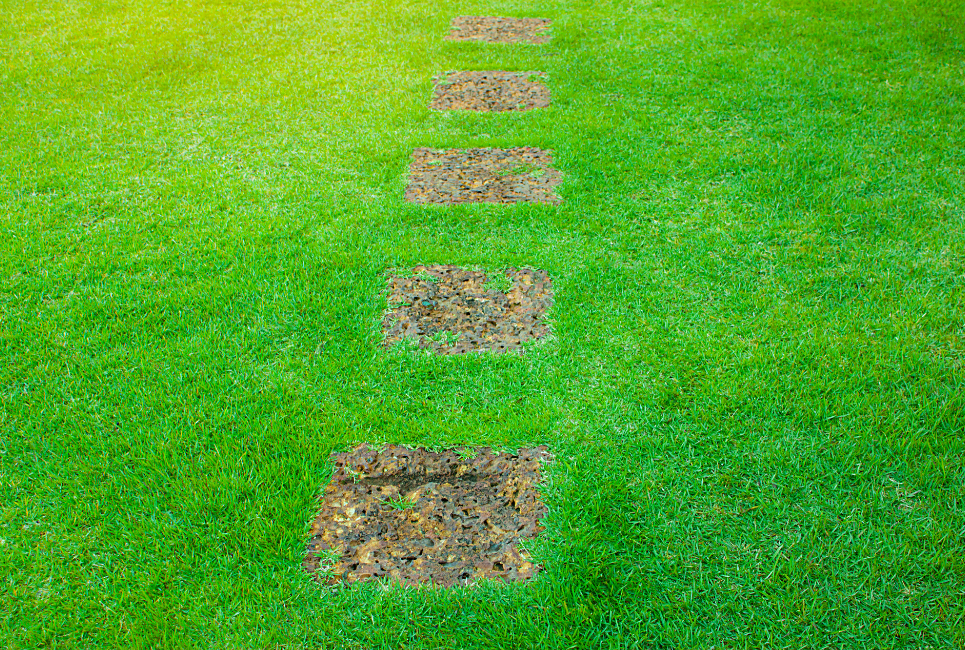
Native to Asia, this grass has been a favorite in the United States since 1895. Zoysia grass is suitable for medium shade areas and yards. It is hardy, drought-tolerant, and requires little to no maintenance.
Zoysia is a warm-season grass, thus striving in temperatures between 80 to 95 degrees Fahrenheit (26.7 to 35 Celsius). During the warmer months of the year, Zoysia thrives and produces a dense, attractive law.
How to Identify Zoysia Grass
Zoysia grass creates a lush lawn with blades of light to medium green blades. When dormant in the colder months, it looks straw-like.
Where does Zoysia Grow?
Zoysia is hardy in USDA zones 5 to 10. This wide growing rage, and the fact that it is drought tolerant, allows the Zoysia to be a grass of choice across the United States. If you have a relatively colder winter, the ‘Meyer’ variety of Zoysia is a safe choice.
How to Plant to Zoysia Grass
Spring, or after all danger of frost is gone, is the best time to plant Zoysia. Some people start by seed, while others prefer laying down sod or inserting plugs. Any of these methods are fine, and it depends on your own personal preference.
Seeds
Here is how to get started with seeds. But keep in mind that it can take up to two seasons before getting a dense turf if you use this method. Apply seed following the package ingredients. Also, make sure to water every day for at least one month after planting. The seedbed needs to be constantly moist for germination.
Sod
Laying sod is the most immediate way to get a lawn. After laying sod, ensure no foot traffic for several weeks while the plants and root system establish themselves—secure sods with stakes in sloped areas to prevent them from shifting out of place. You want to make sure that roots have adequate time to hold onto the soil.
Plugs
Plugs have a piece of rhizome attached to the soil. Plant them about two to three (5 to 7.5 cm.) deep and place about six to twelve (15 to 30.5 cm.) apart. Keep the plugs moist throughout the growing season. Overall, it will take about two full growing seasons for full area coverage.
Sprigs
You can also plant with sprigs, which are similar to plugs. Sprigs are a small portion of a rhizome, root, and leaves – but have no attached soil. They are cheaper than plugs and even require less care. Plant them as you would for plugs—plant in a shallow furrow. Place about 6 inches (15 cm) apart. Ensure that your sprigs do not dry out. To assist in retaining moisture, apply a layer of straw mulch.
How to Care for Zoysia Grass
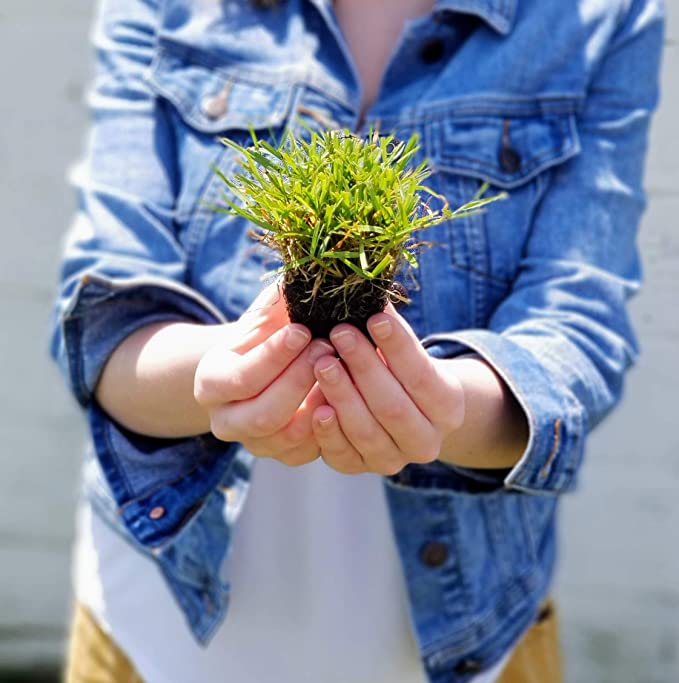
Established Zoysia grass requires little maintenance. Seasonal fertilizing usually is enough.
Mowing
You do not have to mow this grass all the time, but when you do, trim to about one or two inches (2.5 to 5 cm.) in height, which allows weeds to grow and compete with Zoysia.
Light
Zoysia grass prefers full sunlight. If you choose to grow in the shade, ensure that it is a light shade. If shade is too dense, the grass will become thin, which allows weeds to grow and compete with
Soil
Zoysia grass tolerates a wide variety of soils. They will even grow in acidic soils. But if the pH is below 6.0, then you should apply lime. Good drainage is vital as it promotes a deep root system, thus increasing drought tolerance.
Watering
Give your Zoysia grass about an inch of water a week for optimal growth. However, this variety is drought tolerant. To prevent fungal diseases, water early in the morning so that the grass can quickly dry.
Fertilizing
Zoysia does not require much fertilizer compared to other varieties of grasses. About 1 to 3 pounds (0.45 to 1.36 kg) of nitrogen per thousand square feet of lawn is enough—the higher end for sandy soils and the lower end for clay. Try not to over-fertilize as it can promote the development of layers of decomposing roots and stems.
Common Zoysia Grass Problems
Gardeners report few insect or disease problems. The most common problem is usually thatch, which are layers of decomposed roots. It appears brown and spongy and can be found just above the soil surface. Remove with a power rake early in the summer.
Tall Fescue Grass
Tall fescue is perennial cool-season lawn grass. In the milder regions of the United States, such as the Pacific Northwest and northern California, it is a common turfgrass. However, it does fine in most of the United States. It is tough grass for playing areas and can tolerate shade in colder climates.
Scotts® Turf Builder® Dense Shade Mix For Tall Fescue Lawns is a blend noted for its shade tolerance and fast growth. It grows in as 3 hours of daily sunlight. You can purchase these seeds online from Scotts.
How to Identify
Tall fescue creates a dense turf. The leaves are wide blades with a dark green color that lasts through the winter. The blades are coarse to the touch, with shiny topsides. As new blades emerge, they are come out in a rolled-up form.
Tall fescue has an upright, clumping growth habit. Having small rhizomes, they spread mainly by seed distribution as opposed to creeping.
Where does Tall Fescue Grass Grow?
Tall fescue grows hardy to USDA zone 3, making it a choice grass for growers in the warmer regions of Canada and the northern United States.
How to Grow Tall Fescue Grass
You can grow from seeds, plugs, or sods. The aforementioned is a matter of personal preference as this is a relatively fast-growing grass type.
Seeds are a common way to get started with Tall Fescue. Of course, you should follow the seed manufacturer’s instructions, but you will need to evenly moist the soil 14 to 21 days after sowing.
How to Care for Tall Fescue Grass
Tall fescue is relatively low maintenance and does not need frequent mowing and watering. However, it will benefit from some watering during the hot summer months.
Mowing
Keep the lawn at about 2 to 3 inches (5 to 7.6 cm.) tall. Fescue turfs of less than 3 inches (7.6 cm.) tall tend to look thicker and are more attractive.
Light
Tall fescue, like other grasses, prefers full sun. But, it will do fine in partial shade.
Soil
These grasses do fine in many types of soil. They grow deep roots which will find nutrients and moisture in almost any soil variety. Ensure that the soil has good drainage. Also, a pH of 5.5 to 6.5 is optimal.
Watering
Give tall fescue about 1 to 1 ¾ inch (2.54 to 4.44 cm) of water each week. This is a healthy amount but not entirely essential. Soak the soil to approximately a depth of 4 to 6 inches (10.16 to 15.24 cm). As with other grass varieties, deep watering promotes long drought-resistant roots.
Fertilizing
Give tall fescue a yearly feeding of 2.5 to 3 pounds (6.35 to of nitrogen-based fertilizer per 1,000 square feet (9.29 square meters) of lawn.
Common Tall Fescue Problems
This grass is resistant to disease. But, the dwarf varieties of fescue sometimes have problems with a fungal infection called brown patch. The symptoms usually appear in mid-summer, and the only solution is to remove affected areas and re-seed them.
White grubs, armyworm, and cutworm are some of the insects that growers tend to report. If this is your case and you don’t mind applying insecticides, follow the manufacturer’s instructions.
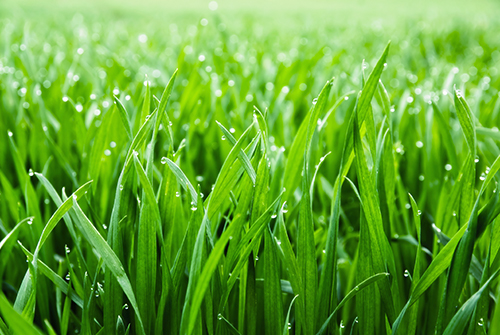
Conclusion
Growing grass in the shade is not easy. Very few grass types are willing to tolerate such unhospitable conditions. Overall, there are three types of grass: low-maintenance and somewhat shade-tolerant – St. Augustine, Zoysia, and Tall Fescue.
If you want to make a turf in a shady spot and have a warm climate, consider Zoysia. Suppose you have a subtropical or tropical climate go with St. Augustine. But, if you want to fill up that shady yard in a cold climate, then Tall Fescue is your best bet.
Frequently-Asked Questions (FAQs)
Question: What is an excellent low-maintenance grass for a shady spot in the Great Lakes region, North Eastern United States, or Southeastern Canada?
Answer: Go with Tall Fescue. When in doubt, this is probably the safer choice. Zoysia and St. Augustine are better for warmer regions of the United States. Also, tall fescue does fine on the Pacific coast.
Question: Is it better to go with seeds, plugs, or sods if I want a lawn in a shady spot?
Answer: This choice is usually a matter of personal preference. St. Augustine does better when grown from plugs or sods. Zoysia grows from any of these methods. But, because Zoysia takes some time to establish itself, if you are looking for a quick fix but want to plant this type – go with sods. Tall fescue is flexible and will strive from any planting method.
Question: My yard gets no sunlight. Should I still consider investing in turf?
Answer: Honestly, it may not be worth the investment if your yard gets less than 3 hours of sunlight each day. Very few grasses, if any, even the most shade tolerant, will perform with less than 3 hours of direct sunlight. It would be best to consider growing some groundcovers in a spot that can tolerate deep shade. A good pick is Hosta, which does well in USDA zones 3 to 9. This plant will do fine in shady spots in most regions of the United States and Canada.
Question: My shady yard tends to retain moisture; which grass will do well in this spot?
Answer: It is probably best to avoid planting grass in areas that retain moisture. You will have trouble in the future as this is the perfect environment for fungal diseases, especially during the warmer months. Check this website out for planting options in wet shade.


